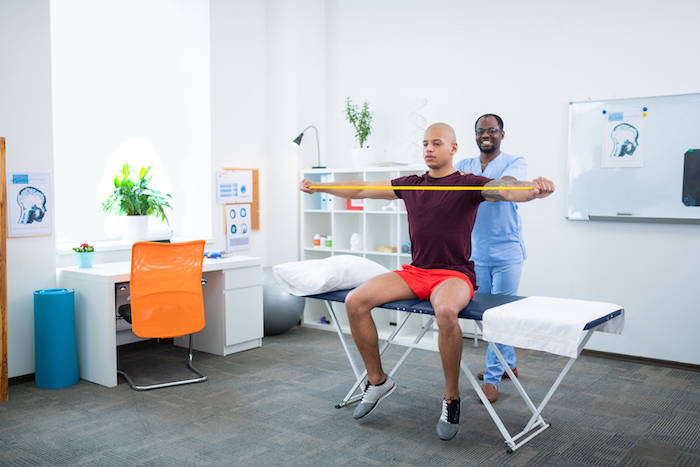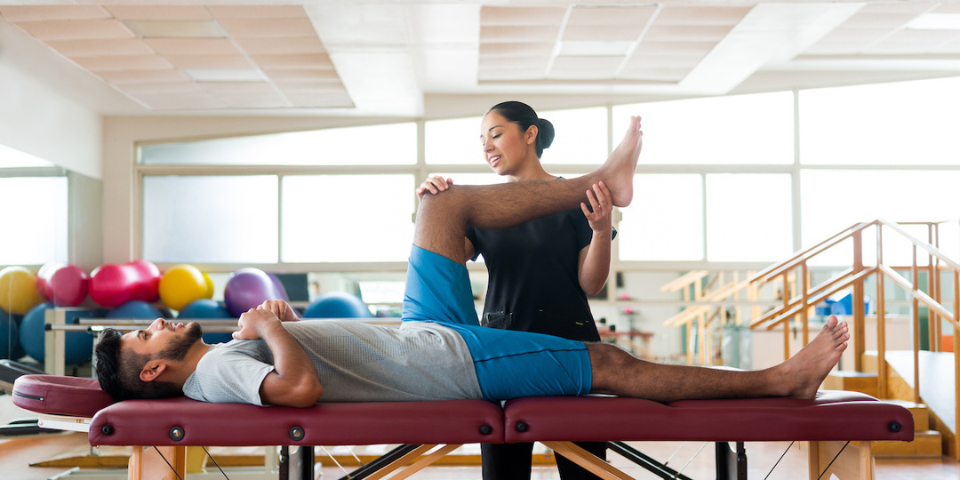Does PNF extend the most effective way to increase mobility?
Expansion It is an integral part of any exercise routine. greater Flexibility We were able to become more resistant to the injury with the gain of strength, but most people only know Two types From the extensions:
- fixed: The traditional expansion, where the muscles are kept in an elongated position for up to 30 seconds (think about the toe) to release tension and make the muscles more flexible.
- mobileMovement -based activities (for example, trunk transformations, The knees are high) To clarify the body to work.
But there is another way to increase flexibility and the range of motion called PNF expansion. If you have ever worked with a personal coach that extended after the exercise or visited a modern stretch studios, you might be aware of this practice already.
Whether you are a beginner or often you have someone else who possesses, here you need to know about the extension of PNF.
What is PNF stretch?

It includes muscle nervous facilitation, or pnf expansion, the extension of the muscles to the maximum and then contracting with the muscles or muscles surrounding the perception of deeper extension – similar Stretch. The goal of this practice is to open greater ranges of movement and improve elasticity.
Physical therapists PNF developed in the 1940s As a way to treat patients with polio and multiple sclerosis and later began to use it for other conditions. “PNF expansion is used primarily in rehabilitation settings and orthopedics to restore flexibility, strength and coordination of the affected muscles,” explains Chris GallurdiDirector of Scientific Education content of the American Council for Exercise. Most often, this expansion is done with a trained partner.
However, anyone who wants to improve mobility can take advantage of PNF techniques. “It is a method of treatment and philosophy that uses the strength of the nervous system to enhance movement,” says personal coach and a physiotherapist. Kitts ChenimanPT, DPT, Comt, CSCS, LMT.
He explains that breaking the abbreviation helps to understand how it works:
- Stimulation: Referring to many sensory receptors that transmit information about the movement and position of the body to the central nervous system.
- Muscle nervousness: the relationship between nerves and muscles/tendons that supply them.
- Facilitate: to make a procedure or process easier.
How does PNF stretch?

Snideman divides PNF concepts into “direct” and “indirect” techniques. The direct methods use the strength provided by the muscles that are extended, while the indirect methods use the strength provided by the muscles that oppose those that are extended.
Direct techniques
The direct techniques of the narrow muscles that are not painful or dangerous are used in stretching. The common expansion method is the contract (CR):
- You can extend the tight muscles to the final range of movement or its shy only if it is painful.
- Then from this position, Unimaginable Contract with muscles (also known as pushing strength without moving the muscles) for five to 10 seconds.
- After a short relaxation, you will find that you can extend the muscles a little deeper.
For example, if you want to extend the tendons of the knee, you will lie on your back and raise your leg as much as you can go while keeping it straight. Next, press opposition power – such as a partner, belt, or wall – as if you were to reduce your leg down, but make sure your leg does not move. After contracting for up to 10 seconds, relax your leg, and you should be able to raise it above than you did previously.
“This technique works through the so -called” relaxation after the standard isis, “Snideman explains,” This means that the muscles have a short period of relaxation after equal measurement. “
This relaxation is possible due to the name called Self -inhibition. When the muscles shrink, the sensory receptors called the organs of the Golgi chord sending the muscle direction signal to the release of tension, allowing them to lengthen. Simply put, the muscles relax themselves when they suffer from a lot of stress.
You can often do the PNF expand directly with a partner or with supports such as a belt or a wall.
Indirect techniques
The indirect techniques use deduction, or opposition, body parts to extend a narrow muscle. “This technique may be better when the muscles are weak or painful in the contract,” Snideman says.
With indirect techniques:
- You can extend the tight muscles to the final range of movement or its shy only if it is painful.
- After that, instead of contracting these muscles, you are similar to other opposition muscles for five to 10 seconds, which in turn helps the narrow muscles relax and extend.
For example, if you want to extend your chest, you will raise your arm until it is parallel to the ground and extends to the back as much as you can without pain. From that point, prepare your arm against a partner or wall behind you and contract the muscles in your shoulders and back back to push against strength. After contracting for up to 10 seconds, relax your arm, and you may find more movement in the initial chest extension.
During this technique, the muscles are involved in mutual discharge. While one muscles are contracting, inhibitory signals relax the conflicting muscles.
The indirect PNF expansion is usually performed with a partner, but it may be possible to extend on your own with the supports, depending on the muscles you target.
When should I do PNF?
Snideman says: “There is no consensus on when it is better to use a stretch pnf,” Snideman says. “But if this type of expansion is used before activity, it may help someone to achieve the scope of the movement they need for any activity about to participate in it.”
It is better to warm up before doing the PNF, as flexibility is trained more effectively when the muscles are warm, and Gagliardi adds.
Also, before exercise, be sure to do some Dynamic expansion After PNF stretch. Otherwise, studies show that you may have Less vertical leap height or Power during exercise.
What are the benefits of PNF extension?

Snideman says: “PNF expansion is often caused more in the movement of movement more quickly than negative or fixed methods,” Snideman says.
in A study published in Sports biology In 2016The researchers divided 40 university students Tight knee strings In four groups. Three days a week for four weeks, students performed:
- Model stretching
- PNF extends
- Tslr stem lifting technique (TSLR) (another technology that increases the elasticity of the knee strings)
- No extension
The stretch pnf and the Mulligan Tslr have increased more than the knee strings of movement than fixed expansion. Even some are considered PNF “The most effective expansion technique” to increase the movement of movement.
Reserves when PNF expansion exercise
To be safe, not only extend with a professional, such as a personal trainer or a physiotherapist trained in this practice. Tell them about any injuries or strains, as contracting with the affected muscles or tendons may exacerbate things, warns Snideman.
This also applies if you have modern surgical operations, because the extension of the affected muscles may weaken healing. Once you know techniques, you may be able to do some PNF stretching on your own.



